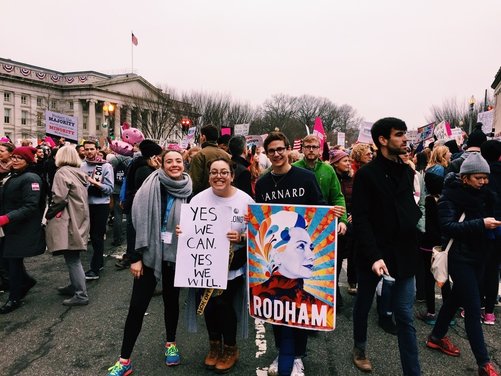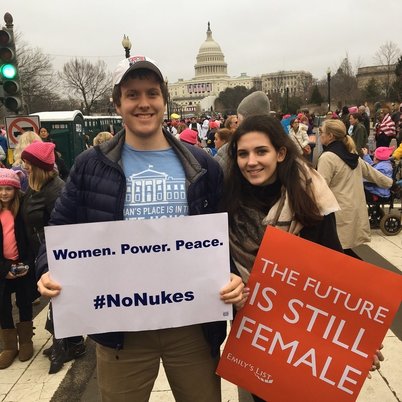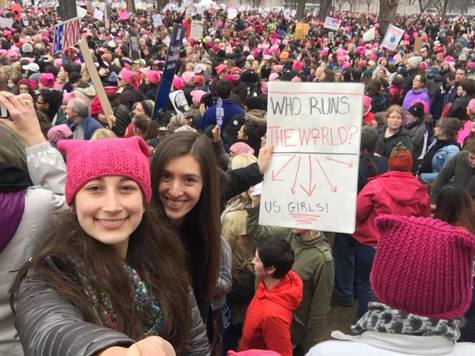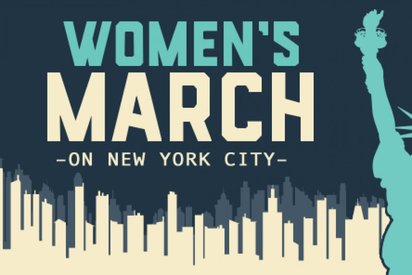Special Edition: Spring 2017
Reflection as Continuation:
The March Continues in Morningside Heights
Students of Columbia University did not just attend the various Marches held around the country in a vacuum: they brought the March back to Columbia. Three Columbia students who marched on Washington on January 21, 2017 share their experiences below as contributions to an immediate history, and moreover as attempts to locate the continuing vitalities of the March and to transform its lessons into an enduring movement. These reflective vignettes are published with temporal distance from the March with this same ideological thrust: to bring the discourses of the March into the present moment.
My America
Jackie Hajdenberg
Jackie Hajdenberg

When we first arrived at the Gallery Place station on the DC Metro on January 20th, I did not think I would be so quickly thrust into such a vast sea of Trump supporters. I turned to my fellow marchers from Columbia/Barnard Hillel, and we all shared the same sentiment: “There are so many of them.” There was an immediate sensation of us versus them; for the first time in my life, I felt like a speck of dust. The day was grim and gray and getting weirder by the minute. My body felt heavy. But the next morning energized me.
We woke up early and breathed the fresh air of the mid-Atlantic. As soon as we stepped outside, that very same air, which the day before felt still and unwelcoming, was suddenly refreshing and liberating. We were immediately greeted by the sight of a group of elderly women wearing pink “Pussyhats,” holding posters condemning bigotry, and pushing their friend in a wheelchair. Other groups soon came into view, with constituents of all ages, genders, and abilities. Suddenly we were sharing smiles with strangers, with the mutual understanding that we were all marching with the same goals in mind.
By the time we reached the meeting point for the March, it was impossible to move more than a few inches at a time. There were tens of thousands of individuals within our view. And while each person had their own purpose for attending the March, it was understood that we were all there for the same reason. The enormous crowd stood huddled together for several hours—much longer than anyone had anticipated, given the number of speakers—before getting restless and moving forward. We continued marching for the rest of the day, passing the sites and symbols that enshrine some of our most American values. But it wasn’t the sight of the Washington Monument or the Capitol Building that made me feel so American; it was the celebration of diversity and progress and this communal exercise in our right to peaceably assemble that gave me great hope for the next few years.
We woke up early and breathed the fresh air of the mid-Atlantic. As soon as we stepped outside, that very same air, which the day before felt still and unwelcoming, was suddenly refreshing and liberating. We were immediately greeted by the sight of a group of elderly women wearing pink “Pussyhats,” holding posters condemning bigotry, and pushing their friend in a wheelchair. Other groups soon came into view, with constituents of all ages, genders, and abilities. Suddenly we were sharing smiles with strangers, with the mutual understanding that we were all marching with the same goals in mind.
By the time we reached the meeting point for the March, it was impossible to move more than a few inches at a time. There were tens of thousands of individuals within our view. And while each person had their own purpose for attending the March, it was understood that we were all there for the same reason. The enormous crowd stood huddled together for several hours—much longer than anyone had anticipated, given the number of speakers—before getting restless and moving forward. We continued marching for the rest of the day, passing the sites and symbols that enshrine some of our most American values. But it wasn’t the sight of the Washington Monument or the Capitol Building that made me feel so American; it was the celebration of diversity and progress and this communal exercise in our right to peaceably assemble that gave me great hope for the next few years.
Jackie Hajdenberg is a sophomore in Barnard College. She can be reached at [email protected].
The Resistance Begins?
Kevin Staples
Kevin Staples

Honestly, I initially did not plan on going to the March on Washington. After dedicating countless hours as a volunteer for the Clinton campaign, making hundreds of phone calls and knocking on countless doors, I felt discouraged and questioned the purpose of the March. I had been actively involved in the campaign since the end of 2015 and truly believed––until November 8th––that the highest glass ceiling would be shattered. But the week before the March I decided that I could not miss it. Though unsure of the impact I would make, I refused to stand silent in the face of the hateful actions and rhetoric of the new administration. To be silent is to take the side of the oppressor.
I marched with my girlfriend and Global Zero, an international movement for the elimination of all nuclear weapons worldwide (full disclosure: I run Columbia’s chapter of this organization). The March began with a rally where several celebrities and activists spoke and performed. I was behind the stage so I could not see the speakers on stage, but still managed to spot Cecil Richards, Emma Watson, Olivia Wilde, and other feminist icons uniting to advance similar messages. The three speakers I found most inspiring were Michael Moore for his capacity to outline concrete plans of resistance, Kamela Harris for her ability to unabashedly stand up for women’s rights while connecting them to other key issues, and Sophie Cruz for her sheer bravery. Cruz is a six-year-old fighting for immigration reform who worries that Trump will deport her undocumented parents; that she could stand on that stage as such a young person and provide solace and hope to hundreds of thousands is remarkable.
Soon, the rally turned into marching and joining in chants, my favorite being: “Welcome to your first day, we will not go away.” A particularly powerful moment was when two young women, no more than ten, began to lead and start many of these chants. They embodied the spirit of Hillary Clinton’s words in her concession speech: “To all of the little girls who are watching this, never doubt that you are valuable and powerful and deserving of every chance and opportunity in the world to pursue and achieve your own dreams.”
I was reminded that the majority of American voters did not vote in Donald Trump and that our generation is undoubtedly not politically apathetic. We were making our voices heard; however, despite the clear energy and spirit, the Democratic Party is at a critical point, in control of neither the Executive nor the Legislative branches of government. We risk the derailment of all progressive policies. While the March offered a proud and unabashed version of liberal America pushing forward progressive policies, can this approach guarantee victory in 2018 and 2020? I worry that pushing too far left may swing the moderate vote towards Republicans. Ultimately, this progressive vision cannot be advanced unless Democrats win in the first place. I think that Kamela Harris’ suggested framing will prove essential; making issues tie back to the economy is crucial to attracting moderate voters. The Women’s March was a moment of resistance, but its effectiveness and ability to lead to concrete political change remains unknown.
I marched with my girlfriend and Global Zero, an international movement for the elimination of all nuclear weapons worldwide (full disclosure: I run Columbia’s chapter of this organization). The March began with a rally where several celebrities and activists spoke and performed. I was behind the stage so I could not see the speakers on stage, but still managed to spot Cecil Richards, Emma Watson, Olivia Wilde, and other feminist icons uniting to advance similar messages. The three speakers I found most inspiring were Michael Moore for his capacity to outline concrete plans of resistance, Kamela Harris for her ability to unabashedly stand up for women’s rights while connecting them to other key issues, and Sophie Cruz for her sheer bravery. Cruz is a six-year-old fighting for immigration reform who worries that Trump will deport her undocumented parents; that she could stand on that stage as such a young person and provide solace and hope to hundreds of thousands is remarkable.
Soon, the rally turned into marching and joining in chants, my favorite being: “Welcome to your first day, we will not go away.” A particularly powerful moment was when two young women, no more than ten, began to lead and start many of these chants. They embodied the spirit of Hillary Clinton’s words in her concession speech: “To all of the little girls who are watching this, never doubt that you are valuable and powerful and deserving of every chance and opportunity in the world to pursue and achieve your own dreams.”
I was reminded that the majority of American voters did not vote in Donald Trump and that our generation is undoubtedly not politically apathetic. We were making our voices heard; however, despite the clear energy and spirit, the Democratic Party is at a critical point, in control of neither the Executive nor the Legislative branches of government. We risk the derailment of all progressive policies. While the March offered a proud and unabashed version of liberal America pushing forward progressive policies, can this approach guarantee victory in 2018 and 2020? I worry that pushing too far left may swing the moderate vote towards Republicans. Ultimately, this progressive vision cannot be advanced unless Democrats win in the first place. I think that Kamela Harris’ suggested framing will prove essential; making issues tie back to the economy is crucial to attracting moderate voters. The Women’s March was a moment of resistance, but its effectiveness and ability to lead to concrete political change remains unknown.
Kevin Staples is a senior in Columbia College. He can be reached at [email protected].
United
Emma Barnett
Emma Barnett

“The People, United, Will Never Be Defeated” --a chant that was repeated hundreds of times at the Women’s March on Washington. Every time the word “united” was chanted, chills shot down my spine. With the continued and intense polarization swallowing our country, this three syllable word, “united,” is more powerful now than ever before. After waking up at 3:45a.m. on the morning of January 21st to catch a four-hour bus ride to DC, less than 24 hours after President Trump’s Inauguration, my friend and I stood for hours, elbow-to-elbow, with more than 500,000 people on Independence Avenue.
At one point we were told that we would be unable to march because there were too many people. This did not stop people from standing right where they were and chanting for what they believed in. All I could see was a sea of pink Pussyhats that seemingly stretched on uninterrupted for miles. There was a sense of trust in the air; people were hugging each other and handing out candies and chocolates. Even the official security weren’t really checking people's bags. There were women and men and children of all different races, ages, ethnicities, and economic backgrounds joined together in the fight for equality. We were all united, and for the first time in a long time, there was a restoration in hope and a recognition that in a democracy, it is the people who elected officials represent (or are supposed to represent). After the chaotic ending to 2016, it was refreshing to be surrounded by people who all wanted love and hope to prevail.
My hope is that this march was not just a moment, but rather a movement. We cannot let the energy from this march fade as time goes on. Instead, we must ensure that the energy and resistance grows. I encourage everyone to volunteer or simply be present somewhere--whether that be volunteering for planned parenthood or at a local public school, calling your representatives on the local and national level, cleaning nature reserves, advocating for the arts, or empowering important movements such as Black Lives Matter and LGBTQIA equality.
As women, united, we need to stand up for each other and not just ourselves. We cannot just fight for what affects our communities, we have to fight for what affects all women; we have to be here for each other. Those who have privilege must mobilize it for change. We all need to be united, not just for this one march but for every humanitarian cause, every single day. We cannot just chant “My Body My Choice” and “Black Lives Matter,” but we have to act in order to ensure ours and our neighbors basic human rights. I marched with the hope that the next generation learns about the fight for gender, racial, and LGBTQA equality as part of a history rather than their reality.
At one point we were told that we would be unable to march because there were too many people. This did not stop people from standing right where they were and chanting for what they believed in. All I could see was a sea of pink Pussyhats that seemingly stretched on uninterrupted for miles. There was a sense of trust in the air; people were hugging each other and handing out candies and chocolates. Even the official security weren’t really checking people's bags. There were women and men and children of all different races, ages, ethnicities, and economic backgrounds joined together in the fight for equality. We were all united, and for the first time in a long time, there was a restoration in hope and a recognition that in a democracy, it is the people who elected officials represent (or are supposed to represent). After the chaotic ending to 2016, it was refreshing to be surrounded by people who all wanted love and hope to prevail.
My hope is that this march was not just a moment, but rather a movement. We cannot let the energy from this march fade as time goes on. Instead, we must ensure that the energy and resistance grows. I encourage everyone to volunteer or simply be present somewhere--whether that be volunteering for planned parenthood or at a local public school, calling your representatives on the local and national level, cleaning nature reserves, advocating for the arts, or empowering important movements such as Black Lives Matter and LGBTQIA equality.
As women, united, we need to stand up for each other and not just ourselves. We cannot just fight for what affects our communities, we have to fight for what affects all women; we have to be here for each other. Those who have privilege must mobilize it for change. We all need to be united, not just for this one march but for every humanitarian cause, every single day. We cannot just chant “My Body My Choice” and “Black Lives Matter,” but we have to act in order to ensure ours and our neighbors basic human rights. I marched with the hope that the next generation learns about the fight for gender, racial, and LGBTQA equality as part of a history rather than their reality.
Emma Barnett is a sophomore in Barnard College. She can be reached at [email protected].
Praying With My Feet
Shira Berkman
Shira Berkman

My decision to join the Women’s March required some contemplation. Not only was the March scheduled on Shabbat, but attending it meant also breaking my otherwise-perfect synagogue attendance. Domestic political awareness and activism have never been my strengths; if this had been any other march, on any other issue, I would have had no hesitations about skipping out. While this country has certainly endured controversial leadership, policies, and politics in the past, those events never seemed to affect me as deeply as they had others. Instead, I always chose to remain silent. January 21st was different. That day, it finally it became personal--as a woman and the granddaughter of Jewish immigrants.
Was it a normal Shabbat? Not quite. But in spite of my secular environs, I attained a unique form of spiritual enlightenment. That Saturday morning, I could not have found a greater alternative to synagogue than marching down those familiar New York City streets. There, I found myself praying for the future of this country alongside my sister, my mother, and hundreds of thousands of like-minded individuals.
I wonder whether prayer is the appropriate term to use in this particular situation. In the communities to which I belong, prayer is the way we thank God for our existence and make requests for the betterment of our people. Yet Rabbi Abraham Joshua Heschel’s alternate definition of prayer, the oft-quoted coinage of activism as “praying with one’s feet,” seemed so fitting at that moment. When I pray with the members of my community on Shabbat, I find encouragement in their attendance. When we pray together aloud, my desire to sustain our age-old traditions is reaffirmed by others who share that same goal. Just as those who surround me in synagogue strengthen my religious passion, my fellow marchers strengthened my dedication to the cause on that cold Saturday in January. There is a supernatural element when people come together. When we share passion, hope, and tradition, the critical role that these gatherings play in our lives are only reinforced.
Was it a normal Shabbat? Not quite. But in spite of my secular environs, I attained a unique form of spiritual enlightenment. That Saturday morning, I could not have found a greater alternative to synagogue than marching down those familiar New York City streets. There, I found myself praying for the future of this country alongside my sister, my mother, and hundreds of thousands of like-minded individuals.
I wonder whether prayer is the appropriate term to use in this particular situation. In the communities to which I belong, prayer is the way we thank God for our existence and make requests for the betterment of our people. Yet Rabbi Abraham Joshua Heschel’s alternate definition of prayer, the oft-quoted coinage of activism as “praying with one’s feet,” seemed so fitting at that moment. When I pray with the members of my community on Shabbat, I find encouragement in their attendance. When we pray together aloud, my desire to sustain our age-old traditions is reaffirmed by others who share that same goal. Just as those who surround me in synagogue strengthen my religious passion, my fellow marchers strengthened my dedication to the cause on that cold Saturday in January. There is a supernatural element when people come together. When we share passion, hope, and tradition, the critical role that these gatherings play in our lives are only reinforced.
Shira Berkman is a sophomore in the joint program between List College and the School of General Studies. She can be reached at
[email protected].
[email protected].